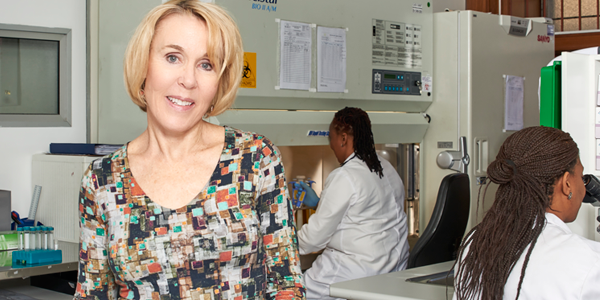Wits Prof advises Ebola vaccination strategy update to account for DRC insecurity
- Wits University
An advisory group of the World Health Organization has issued new recommendations to address vaccination challenges in the ongoing Ebola outbreak in the DRC.
Professor Helen Rees, Executive Director of the Wits Reproductive and HIV Research Centre, is Co-Chair of the Strategic Advisory Group of Experts (SAGE) appointed by the World Health Organization (WHO).
The recommendations include endorsing operational adjustments that make the vaccination process faster and adjusting the dosage based on available efficacy data. The SAGE also suggested expanding the population eligible for vaccination, introducing an additional experimental vaccine, and redoubling efforts to train nurses, doctors and medical students from Ebola-affected communities to work on vaccination teams.
Vaccination saving lives but challenges remain
More than 111 000 people have been vaccinated in the Democratic Republic of the Congo (DRC) since the outbreak was declared in August 2018. However, despite the use of a highly efficacious vaccine, the number of new cases continues to rise, in part due to repeated incidents of violence affecting the ability of response teams to immediately identify and create vaccination rings around all people at risk of contracting Ebola.
“The SAGE emphasized that ring vaccination of contacts, and contacts of contacts, continues to be the preferred strategy. However, the Working Group recognised that the current emergency and the available evidence called for a dose-adjusted approach to ensure vaccine continues to be available and offered to individuals at greatest risk of Ebola,” said Rees.
Pop-up and targeted geographic vaccination
The SAGE endorsed the use of pop-up and targeted geographic approaches to vaccination when appropriate. The WHO has already used these vaccination successfully in the field to make the ring vaccination process faster, more secure, and more responsive to community feedback.
In view of the fact that insecurity limits the time that vaccination teams can spend in some communities, and in response to community requests, SAGE recommended steps to streamline implementation of the vaccination protocol. SAGE also endorsed a modified follow-up for safety monitoring.
Adjusting vaccine dosage and eligible populations
In addition to vaccinating contacts and contacts of contacts, SAGE now also recommends vaccinating those who could be part of tertiary chains of transmission, such as people in villages and neighborhoods where cases have been reported within the past 21 days. SAGE noted that increasing access to vaccination in the broader community may help enhance community acceptance of the vaccine and other control measures. SAGE also recommended adjusting the dose of the vaccine currently being used.
People at highest risk (contacts and contacts of contacts) will now receive 0.5ml of vaccine instead of 1ml. Those for whom a rapid evolution of the immune response is less critical (people who are considered lower-risk / those who could be potentially involved in tertiary transmission) will receive 0.2ml (1/5 of the current dose).
Plans for deployment of an additional vaccine underway
The SAGE reiterated its previous stance stating the need to assess additional Ebola vaccines. SAGE now additionally recommends offering an alternative vaccine to those at lower risk within affected health areas.
The adenovirus 26 vectored glycoprotein / MVA-BN (Ad26.ZEBOV/MVA-BN) investigational Ebola vaccine, developed by Johnson & Johnson, is being considered and a coalition led by the Coalition for Epidemic Preparedness (CEPI) and the London School of Hygiene and Tropical Medicine, and other partners, with support from WHO, are at an advanced stage towards the deployment and assessment of this vaccine.
Training and engaging more members of affected communities
WHO and partners are working to engage further Congolese nationals from within Ebola-affected communities. The goal is that by end of the month a majority of vaccination team members are healthcare workers, doctors and medical students from affected communities who also speak the local languages.
Dr Tedros Adhanom Ghebreyesus, WHO Director-General, said: “We know that vaccination is saving lives in this outbreak. We also know that we still face challenges in making sure the contacts of every case receive the vaccine as soon as possible. These recommendations account for ongoing insecurity and incorporate feedback from experts and from the affected communities that will help us continue to adapt the response.”

